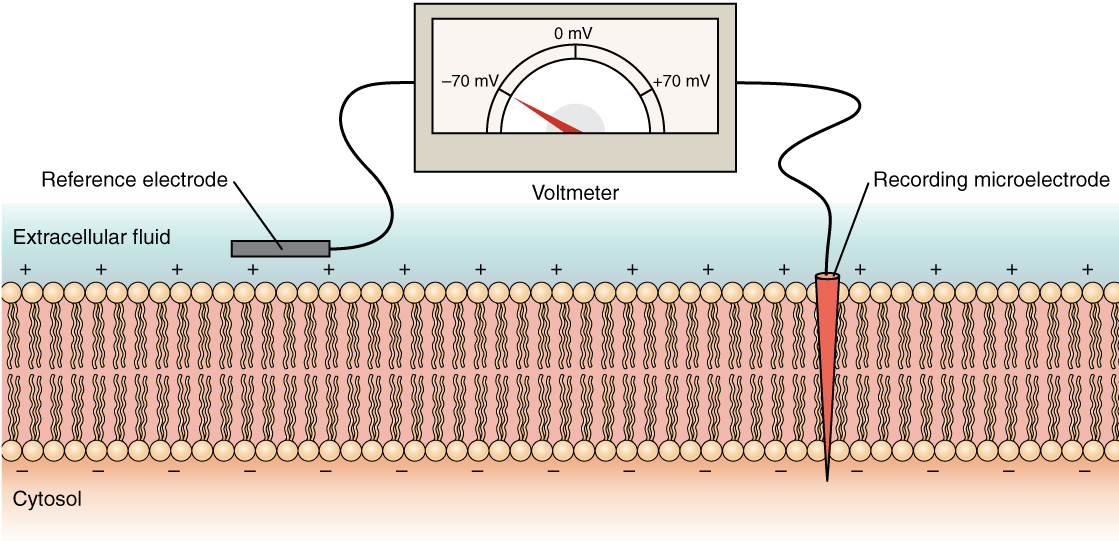12 Membrane potential
Learning Objectives
At the end of this section, you should be able to-
- Define resting membrane potential.
- Explain the role of ion concentration gradients and membrane permeability to ions in establishing a membrane potential.
- Explain how the sodium-potassium pump helps maintain the resting membrane potential.
- Describe the physiological basis of the resting membrane potential (RMP) in a neuron including the ion channels involved, the relative ion concentrations, and the electrochemical gradient.
- Describe the role of the sodium-potassium ATPase pump in maintaining the resting membrane potential.
The membrane potential is a distribution of charge across the cell membrane, measured in millivolts (mV). The standard is to compare the inside of the cell relative to the outside, so the membrane potential is a value representing the charge on the intracellular side of the membrane (based on the outside being zero, relatively speaking) (Figure 12.1).

Resting Membrane Potential
There is typically an overall net neutral charge between the extracellular and intracellular environments of the neuron. However, a slight difference in charge occurs right at the membrane surface, both internally and externally. It is the difference in this very limited region that holds the power to generate electrical signals, including action potentials, in neurons and muscle cells. When the cell is at rest, this charge difference across the membrane is known as the resting membrane potential.
When the cell is at rest, ions are distributed across the membrane in a very predictable way. The concentration of Na+ outside the cell is 10 times greater than the concentration inside. Also, the concentration of K+ inside the cell is greater than outside. The cytosol contains a high concentration of anions, in the form of phosphate ions and negatively charged proteins. With the ions distributed across the membrane at these concentrations, the difference in charge is described as the resting membrane potential. This charge difference arises because of the ion concentration gradients and the selective permeability of the membrane to these ions. Na+ tends to move into the cell, and K+ tends to move out, driven by their respective concentration gradients. However, the membrane is more permeable to K+, leading to a greater movement of K+ out of the cell than Na+ into the cell, which contributes to the negative charge inside. The exact value measured for the resting membrane potential varies between cells, but -70 mV is a commonly reported value. This voltage would actually be much lower except for the contributions of some important proteins in the membrane. Leak channels allow Na+ to slowly move into the cell or K+ to slowly move out, and the Na+/K+pump restores their concentration gradients across the membrane. This may appear to be a waste of energy, but each has a role in maintaining the membrane potential. The sodium-potassium pump, also known as the Na+/K+ ATPase, actively transports 3 Na+ ions out of the cell and 2 K+ ions into the cell against their concentration gradients using ATP. This active transport is crucial for maintaining the concentration gradients of Na+ and K+ across the membrane, which are essential for the resting membrane potential.
Adapted from Anatomy & Physiology by Lindsay M. Biga et al, shared under a Creative Commons Attribution-ShareAlike 4.0 International License, chapter 12.
the distribution of voltage across the cell membrane
fluid portion of the cell made up of the cytosol and cytoplasm; where chemical reactions occur
the difference in charge between the inside and outside of the cell

